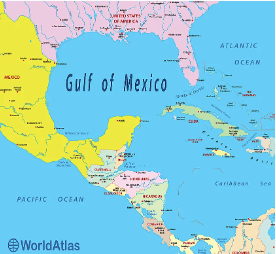Map:2sjlzzw4w0a= Gulf of Mexico

The Gulf of Mexico is an intricate tapestry of ecological and economic significance, characterized by its rich biodiversity and complex coastal formations. As a crucial hub for fishing and tourism, its annual economic output exceeds $300 billion. However, this region is increasingly threatened by environmental challenges such as pollution and climate change. The interplay of these factors raises important questions about sustainability and the future of this vital ecosystem. What strategies are necessary to balance economic interests with ecological preservation in the Gulf?
Geographic Overview
The Gulf of Mexico’s unique geographic characteristics significantly influence its ecological and economic dynamics.
Its diverse coastal features, including estuaries and barrier islands, interact intricately with prevailing ocean currents.
These currents not only regulate temperature and salinity but also facilitate nutrient distribution, impacting marine resources and regional economies.
Understanding these geographic elements is vital for sustainable management and harnessing the Gulf’s potential.
See also: Map:2imgs9zsvam= Valencia
Biodiversity and Ecosystems
A remarkable array of biodiversity characterizes the Gulf of Mexico, reflecting a complex interplay of various ecosystems that support an abundance of marine and coastal life.
Essential marine species thrive within habitats like coral reefs and coastal wetlands, contributing to ecological balance.
Effective habitat conservation is vital, as trophic interactions among species underline the intricate relationships that sustain this diverse environment.
Economic Importance
Valued at over $300 billion annually, the Gulf of Mexico plays a crucial role in the economy of the United States and surrounding regions.
The fishing industry thrives here, contributing significantly to local livelihoods and food security.
Additionally, tourism revenue, driven by the region’s natural beauty and recreational opportunities, bolsters economic growth, emphasizing the Gulf’s multifaceted importance in fostering regional prosperity and sustainability.
Environmental Challenges
Frequently overlooked in discussions of economic contributions, the environmental challenges facing the Gulf of Mexico are profound and multifaceted.
Pollution sources, including agricultural runoff and industrial discharges, exacerbate the ecological decline, while climate change intensifies issues such as rising sea levels and increased storm frequency.
These intertwined factors threaten biodiversity, disrupt marine ecosystems, and undermine the region’s sustainable future, demanding immediate, multifaceted interventions.
Conclusion
In the intricate tapestry of the Gulf of Mexico, the interplay of vibrant ecosystems and economic vitality symbolizes the delicate balance between human endeavor and environmental stewardship. The Gulf, much like a fragile glass ornament, reflects the beauty of biodiversity while simultaneously warning of the precarious nature of its health. Addressing pollution and climate change is imperative to preserve this irreplaceable treasure, ensuring that future generations inherit not only its wealth but also its ecological integrity.




